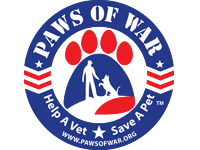Helpful Tips Throughout The Year
Each season poses different potential hazards to your Service Dog. Here are some seasonal canine health tips to help guide your throughout the year.
HOw to Keep Your Service Dog Cool in the Summer
to Keep Your Service Dog Cool in the Summer
Summer can mean lots of fun outside with your Service Dog. But when the temps soar, take steps to protect your dog. Whether you take him for a walk down the street, a ride in the car, or just out in the yard to play, the heat can be hard on him. Here's how to keep your furry best friend safe.
Never leave your dog in the car. No, not even if you think you’ll only be a few minutes. Even when it isn’t that hot outside, the temp can soar inside a closed car. On an 85-degree day, it can reach 102 F within 10 minutes. And that's with a window cracked. After 30 minutes, it could be up to 120. Leave your dog at home, or go places where he can come with you.
Keep your house cool. If Fido’s home alone, make sure he can truly chill. Leave the air conditioner on and close the drapes. If you don't have AC, open the windows and turn on a fan. You may want to try a cooling vest or mat to see if they help.
Watch when you exercise. Limit when and how much you do when it's hot and humid. Take walks in the cooler part of the day, in the early morning and evening hours. Carry water, too -- enough for both of you.
Check the pavement. Before you head out for a walk, touch the pavement. If it's too hot for your hand, it's too hot for your dog's paw pads. Walk on the grass and stay off the asphalt. You also might want to try booties for your dog so his paws don’t burn.
Offer plenty of water and shade. Don't leave your dog alone outside for long. And when he is there, make sure he has shade and lots of fresh, cool water. Add ice cubes when you can. Trees are better than doghouses for shade. They let air flow through. Doghouses can trap the heat and make it worse. Think about a kiddie pool or a sprinkler to help your pal cool off in the yard.
Make cool treats. Help your canine chill from the inside out. For puppy popsicles, make ice cubes with tasty treats inside. Or fill and freeze a chew toy to make a chilly snack.
Keep an eye on the humidity, too. When the air is full of moisture, your dog may not be able to pant enough to cool himself off. That can raise his temperature, which can lead to heatstroke. Stay inside, and limit exercise, too.
Groom your pet. If your dog has long hair, get rid of any mats and tangles. It will help keep him cool. Don't shave or clip his coat before you talk to your vet or groomer. The extra fur that keeps him warm in winter may also keep him cool in summer.
Visit your vet. Keep your dogs shots up to date, especially in summer. The parvo virus spreads in hot weather. And your dog probably spends more time outside, which means it’s more likely he could come into contact with a critter that has rabies. Summer is high season for fleas, which spread many diseases, and mosquitoes, which carry heartworm. Get your dog on regular meds to prevent these pests.
Watch for signs of overheating. Your dog can't tell you when he doesn't feel well, so keep an eye out for heatstroke, which can have these symptoms:
- Heavy panting
- Heavy drooling
- Trouble breathing
- Rapid heartbeat
- Dark or red gums and tongue
- Dizziness
- Weakness
- Agitation
If you see any signs, get him to the vet right away.
Winter Tips
When the weather is cold and dry or wet and cold, service dogs require extra loving care to stay in tip top shape while traveling.
Not only is the weather and extreme temperature a concern but de-icing agents used on walkways and streets can pose a threat if ingested by paw licking.
With a little extra thought and planning you can enjoy winter weather travel with your dog for many years to come.Here are a few precautions you can take to keep your service dog healthy and safe!
- Keep paws and nails clipped and groomed to minimize the clinging of salt and de-icing chemicals.
- After walks and when returning from outdoors, wash and wipe your service dog’s paws to remove chemicals and de-icing agents.
- Avoid over bathing your dog during harsh winter weather as repeated bathing eliminates essential skin and fur oils which can lead to stripping of the oils and dry and flaky skin issues.
- Consider a warmer more insulated service dog vest specifically for colder climate to keep your service dog more comfortable. Winter booties may be necessary for service dogs in extreme weather and can help minimize irritation and accumulation of salts and chemicals between the dog’s toes.
- Service dogs work hard and they require extra energy during extreme cold temperatures. Provide extra food and water during this time to meet the additional needs of both service dogs and pet dogs.
- Use common sense. If the weather is uncomfortably cold or harsh for you, then it is likely the same for your service dog or pet. When traveling to new climates it takes some time for your dog to adjust like it does for a person.
Supervise your dog around fireplaces. If you love a toasty fire on a cold winter day, be sure to supervise your dog around the fireplace. Use a screen to protect your dog from flames and soot.
Don’t leave your dog alone in the car. In cold weather, cars can act as giant refrigerators, and it can quickly become dangerous for dogs. If you’re running errands or traveling, and you think you might not be able to take your dog inside with you, it might be better to leave them at home.
Watch for frostbite. Dogs can get frostbite, too. Watch for red, gray, blue, or whitish areas on the nose, ears, and feet. Dogs may have fur coats, but if it’s cold enough that you want to go back inside, it’s probably time for your dog to come in, too. And remember, puppies don’t tolerate the cold as well as adult dogs do.
Be prepared for winter storms. If a winter storm is predicted, make sure you have enough dog food, fresh water, warm bedding, and any meds your dog is taking in case you get snowed in.
Wear collars and ID tags outside. Dogs can easily lose their scent in the snow and ice and may not be able to find their way home if they get away. Every time you take your dog outside, whether it’s on a leash or just in your backyard, make sure your dog is wearing a collar and ID tags.
Dogs & Fireworks
Fireworks can be fun for humans, but dogs don't have the same reaction.
In the United States on July 4th, fireworks inevitably come with this holiday. Almost all humans with canines in the U.S. declare this day the worst day of the year for their dogs. Veterinarians say that July 3rd is usually the most trafficked day in their offices, with clients coming in to get drugs for their dogs.
Here are a few tips for providing a safe July 4th for your Canine Household:
- Make sure your dog gets plenty of exercise earlier in the day.
- Keep your dogs inside during fireworks, preferably with human companionship. If it’s hot, air conditioning will help. Bringing your dogs to a fireworks display is never a good idea.
- Provide a safe place inside for your dogs to retreat. When scared of sounds they can’t orient, dogs often prefer small enclosed areas. If your dog is comfortable in a crate, that is a good option.
- If possible, keep the windows and curtains closed. Covering the crate or lowering the blinds can also be helpful. Removing visual stimulation can also help calm dogs.
- Make sure all your dogs are wearing ID tags with a properly fitting collar.
- Leave your dog something fun to do – like a frozen Kong filled with his favorite treats.






